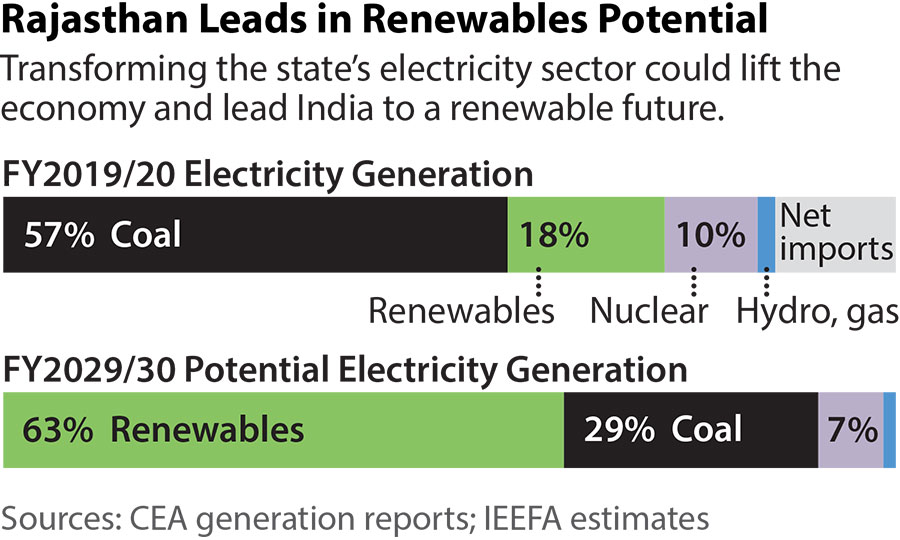IEEFA India: Renewables-rich Rajasthan has potential to lead India’s energy transition

17 September 2020 (IEEFA India): As India looks to expand its renewable energy capacity, a new report from IEEFA finds that Rajasthan can play a key leadership role in the country’s transition to a low-cost, low-emission, profitable electricity system.
Rajasthan’s installed renewable energy capacity reached 9.6 gigawatts (GW) at the end of fiscal year (FY) 2019/20. It also added more solar power capacity (1.7GW) in FY 2019/20 than any other Indian state, ahead of Karnataka (1.4GW), the state with the highest installed solar capacity, and Tamil Nadu (1.3GW).
“Rajasthan has a bright future as a renewable energy leader in India,” says the report’s author Kashish Shah, Research Analyst at the Institute for Energy Economics and Financial Analysis (IEEFA). “But its power distribution companies (discoms) are among the worst performing in India.”
Expensive coal-fired capacity tariffs coupled with huge aggregate technical and commercial (AT&C) losses led to the Rajasthan discoms booking a loss of Rs6,355 crore (US$900m) in FY2019/20 after accounting for state government subsidies.
“A shift to cheaper renewable capacity could help alleviate the discoms’ financial liquidity and cash flow issues,” says Shah.
RAJASTHAN HAS HIGH SOLAR RADIATION AND WIND SPEEDS AND AN ABUNDANCE OF BARREN LAND THAT MAKE IT SUITABLE FOR UTILITY-SCALE SOLAR PARKS. And it is already home to the world’s largest solar park – the 2.25GW Bhadla Solar Park, located in Jodhpur district.
“These factors make Rajasthan an attractive destination for domestic and foreign investors looking for opportunities in renewable energy, electricity grid infrastructure and associated manufacturing,” says Shah.
Currently Rajasthan depends on electricity imported from other states given a power deficit during peak daytime hours. With an increase in renewable energy investment the state could become a net exporter of electricity in the coming decade, according to the report.
“It makes sense for Rajasthan to export electricity to other states. Yet we estimate it imported 10.9 terawatt hours (TWh) in FY2019/20,” says Shah. “The state government should be taking proactive measures to fully utilise Rajasthan’s renewable energy potential and build capacity to transmit power to states with energy deficits.
“Revenues from the interstate export of power would help sustainably grow GDP and improve India’s energy security and load balancing capacity.”
Today renewable energy sources form 43.5% of Rajasthan’s operational installed capacity and produce 17.6% of its total on-grid generation. Meanwhile the state’s 9.8GW of coal-fired capacity makes up 45% of total installed capacity and produces 56.5% of total on-grid generation.
But Rajasthan’s electricity sector could look very different by the end of this decade, IEEFA’s modelling suggests.
“We forecast that the composition of the electricity sector will shift dramatically, with renewables forming 74% of capacity and 63% of total generation by FY2029/30,” says Shah.
“Our model forecasts a total of 22.6GW of renewable energy to be added to Rajasthan’s grid. This will consist of 18GW of new solar capacity, of which 3GW is forecast to be distributed solar capacity.
“We estimate solar will supply 98% of the incremental electricity demand by FY2029/30; and that 4GW of new onshore wind power capacity will serve 45% of the incremental demand.
“AS THE DISCOMS LOOK TO CATER TO THEIR INCREMENTAL DEMAND THROUGH CHEAPER, DEFLATIONARY RENEWABLES, COAL-FIRED PLANTS WILL PROGRESSIVELY LOSE OUT ON MARKET SHARE to about 28% or 13TWh by FY2029/30.”
The modelling in the report takes into account India’s economic slowdown and the COVID-19 pandemic which has led to falling electricity demand. IEEFA projects Rajasthan’s electricity requirements to grow by only 42% over the next decade – from 81TWh in FY2019/20 to 115TWh in FY2029/30 – a growth well below any forecasts set even two years ago.
The report predicts the state will gradually retire its highly polluting, outdated and end-of-life coal-fired power plants. It models a net reduction in coal capacity of 0.7GW by FY2030.
“The energy landscape is changing rapidly,” says Shah. “With net coal capacity closures over the coming decade, we forecast the coal-fired power sector’s utilisation rates will drop to 41% in FY2029/30 from an already unsustainably low 55% in FY2019/20.
“If Rajasthan fulfils its solar power potential, it could be one of the largest contributors to India’s target of 450GW of renewable energy by 2030 – and provide a model for other states to follow.”
Full report: Transforming Rajasthan’s Electricity Sector
Media contact: Rosamond Hutt ([email protected]) +61 406 676 318
Author contact: Kashish Shah ([email protected])
About IEEFA: The Institute for Energy Economics and Financial Analysis (IEEFA) examines issues related to energy markets, trends and policies. The Institute’s mission is to accelerate the transition to a diverse, sustainable and profitable energy economy.











